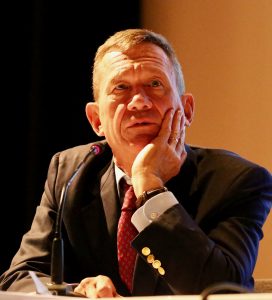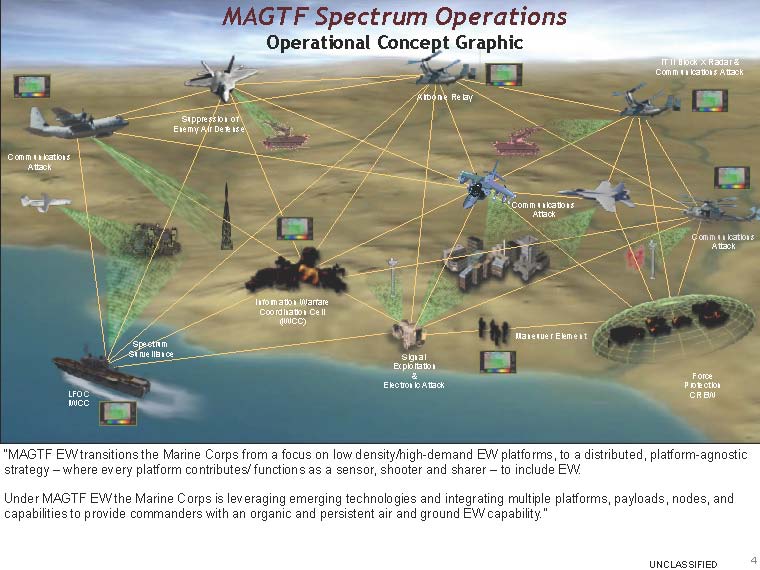2017-08-31 By Robbin Laird
On August 23, 2017, the Williams Foundation held a seminar on the future of electronic warfare.
With the introduction of the Growler, this has provided a natural hook into the broader discussion of the evolving payloads, which need to be part of an integrated 21st century combat force.
As Group Captain Braz put the objective of Growler introduction within the ADF:
“New thinking in terms of dynamic targeting, particularly of non-lethal effects, many of which may be temporary in nature, will be a key to success.
“Delegating these engagement authorities forward will be essential.”
Lt. General (Retired) Jon Davis, the former Deputy Commandant of Aviation, echoed these sentiments within his presentation to the Williams Foundation seminar.
He described the USMC transition from a core aircraft delivering an EW effect to building out the MAGTF to include ubiquitous access to non-kinetic tron warfare capabilities.
The core approach going forward is very clear.
“MAGTF EW transitions the Marine Corps from a focus on low density/high-demand EW platforms, to a distributed, platform-agnostic strategy – where every platform contributes/ functions as a sensor, shooter and sharer – to include EW.
“Under MAGTF EW the Marine Corps is leveraging emerging technologies and integrating multiple platforms, payloads, nodes, and capabilities to provide commanders with an organic and persistent air and ground EW capability.”
 Lt. General (Retired) Jon Davis on a panel at the Williams Foundaton Seminar on Electronic Warfare, August 23,
Lt. General (Retired) Jon Davis on a panel at the Williams Foundaton Seminar on Electronic Warfare, August 23,
2017
Davis underscored that with the changing nature of warfare and how the Marines operate, shaping a distributed strategy was a necessity, not an option.
“We operate on ships, from ships to shore and ashore.
“We cannot simply have an on call EW asset.
“We can confront the threat requiring an EW capability anywhere we operate.”
He described the sun setting of the unique EW aircraft, the Prowler, in favor of a sequential role out of distributed capability to the MAGTF.
He focused initially on Intrepid Tiger which is an EW pod being incorporated the Marine Corps legacy air.
It is on the Harrier and UH-1Y currently but will be added to other aircraft in the force.
“It’s made over 20 deployments now.
“It’s an open architecture system.
“It does electronic surveillance; it does electronic attack.
“We have a new one called Intrepid Tiger Block 2X which is being built to do radar jamming.
“It’s about 305 pounds for the Harriers and Hornets.
“It’s going to go next on V-22 then on C-130 and then on the CH-53 helo.
“We had about 120 we’ve built so far, we have 268 in the program of record.”
It’s completely an open architecture.
“And we have invited manufacturers if they have a card that can fit into the system to propose putting it into the pod.
“If you have a card that fits in that slot and you can do so, bring it and you can plug it in, but do not ask us to change the box for us to take your card.
“You have to adapt your card to fix my box.”
The Marines are deploying the F-35 at the same time, which is a core capability for the USMC in delivering non-kinetic effects throughout the distributed force as well.
“The F-35 is part of our electronic warfare strategy for the United States Marine Corps. Indeed, it is a key part of our strategy.”
He then described an exercise involving the F-35.
“We were doing a drill, and the F-35 does a great job at a lot of things.
“It does a very good job in terms of electronic warfare as well.
“Bottom line, I was out there, I saw four ship of F-35s, and the scenario was a double digit SAM threat, it was 1,000 foot overcast, we had four Bs out there, we had a forward air controller on the ground, and these guys had launched off the ship and they were overhead, and they were going to go take out ground vehicles and suppress and shutdown the SAM.
“We brought in all of our senior one and two star generals. In short period of time, the F-35s got rid of the SAMs.
“They were operating more like a pack of dogs than ever seen in 36 years of flying strike airplanes including being the CO of the Weapons School.
“It was a work of art.
“The infantry officer came at the end came up says, “Hey, that was fantastic, but I think that’s not very realistic.”

“We need to capture it on live streaming video see we can see a confirmation of those targets.”
“I commented: Well it’s overcast, they’re not going to be streaming video, and you’re probably not going to have a Reaper out there, right? It’s going to get shot down.”
“He goes, “We need more time so we can review the video feeds.”
“I said, we have to remove the admirals and the generals out of the kill chain.
“If the pilots have got the right RoE, let them loose.
“If you inject too many decision makers from on high, you’re going to get Solders, Sailors and Airmen killed.”
Davis added: “We’re going to grow the F-35; We’re going to be very aggressive about growing capabilities in the F-35. It’s good at what it does right now; it’ll be a hell of a lot better in the future.”
He then went on to describe other roll-outs of evolving EW capability for the MAGTF.
The Blackjack UAV, which has a modular payload structure, has an EW payload inside as well and is currently working with the USS America amphibious group.
The goal is clear: “There will never be a Marine infantry unit or a group on the ground that will not have access to electronic warfare capability.
“The guys on ground can go up and e-connect.
“Almost like they’re going to a server in the sky and pulling the information for them, he or she can basically pull the capability down from the air asset.”
The next platform, which will provide an EW delivery capability to the MAGTF will be the Group 5 UAV, the Marines are working on right now.
This will be a VTOL UAV and will have an open architecture with modular payloads.
And clearly one of those payloads will be an EW one. And by having a VTOL asset this can provide MAGTF support throughout its operational cycle, whether on the ship, coming off the ship or operating ashore.
He concluded by reminding the audience of the philosophy of the Marine Corps as the big green killing machine. It was not about the fair fight; it was about speed and combat success against a determined enemy.
He quoted the most famous Australian general officer from World War I, General Sir John Monash to provide perspective on how the Marines looked at the inclusion of EW as a ubiquitous asset for the MAGTF.
“The true role of infantry was not to extend itself upon heroic physical effort, not to whither away under merciless machine gun fire, not to impale itself upon hostile bayonets, but on the contrary, to advance under the maximum possible array of mechanical resources, in the form of guns, …tanks, mortars and aircraft; to advance with as little impediment as possible; to be relieved as far as possible of the obligation to fight their way forward.”
Editor’s Note: During the panel discussion after the presentations by Group Captain Braz and CDR Mike Paul, a question was asked about the challenge of working with the US Navy and its approach leveraging Growler and the USAF’s approach to leveraging fifth generation aircraft in shaping a way ahead.
The answers were quite noteworthy.
Group Captain Braz viewed the RAAF as in an interesting bridging function between the USN and USAF and playing a potentially useful and significant role in shaping integrated capability across the RAAF, the USN, and USAF as well.
“The diversity that we bring is very useful in shaping the combined team of US Navy and US Air Force capabilities.”
Lt. General (Retired) Davis from the floor added his thoughts on how integration is proceeding in the US.
He sees the schools, MAWTS-1, Nellis and Fallon as key elements in shaping an integrated force. He mentioned that a Marine is for the first time teaching at Nellis and a USAF pilot is training at MAWTS-1 and will be an instructor there as well.
“The more we learn from each other, the better we will be.”
And then CDR Paul added that it remains to be seen how the US Navy will employ the F-35 but that cross learning from the USMC and the USAF will be crucial in this process.


